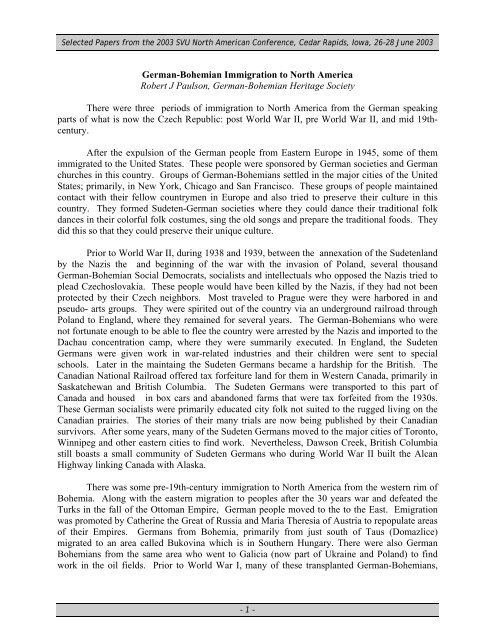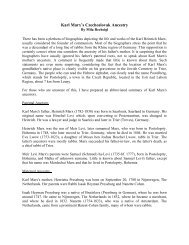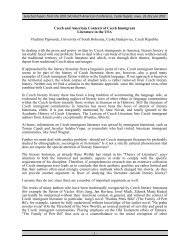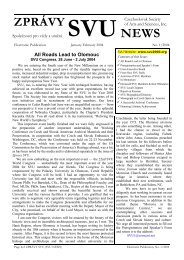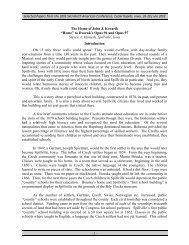German-Bohemian Immigration to North America - Czechoslovak ...
German-Bohemian Immigration to North America - Czechoslovak ...
German-Bohemian Immigration to North America - Czechoslovak ...
You also want an ePaper? Increase the reach of your titles
YUMPU automatically turns print PDFs into web optimized ePapers that Google loves.
Selected Papers from the 2003 SVU <strong>North</strong> <strong>America</strong>n Conference, Cedar Rapids, Iowa, 26-28 June 2003along with the <strong>German</strong>s from Russia and the Donauschwaben, fled <strong>to</strong> the United States, primarily<strong>to</strong> the Dakotas and central Canada. There is a very active Bukovina Society in Ellis, Kansas.The primary emigration came in the mid 19th-century. The earliest documentedimmigration of <strong>German</strong> <strong>Bohemian</strong>s <strong>to</strong> the United States was in the early 1850s, shortly after thefailed 1848 revolution. I am certain that there were individuals and small groups whoimmigrated earlier but these people tended <strong>to</strong> assimilate in<strong>to</strong> the existing <strong>German</strong> communities inthis country. I am also certain that there were small numbers of <strong>German</strong> <strong>Bohemian</strong>s in theeastern port cities of New York and Baltimore, but these, <strong>to</strong>o, are difficult <strong>to</strong> identify, and for thesame reason.There were two groups along the western migration routes, however, that can beidentified. Along the northern migration route that extended <strong>to</strong> the Great Lakes, there was sizable<strong>German</strong> <strong>Bohemian</strong> community in Buffalo, New York, clustered around the industrial area of thecity. Many of these <strong>German</strong> <strong>Bohemian</strong>s worked in Buffalo's breweries, near the waterfront.Along the Southern route there was another group of <strong>German</strong> <strong>Bohemian</strong> settlers in andaround Pittsburgh and Allen<strong>to</strong>wn working in the steel mills and glass fac<strong>to</strong>ries. Interestingly, thecottage glass industry was highly developed in the forested areas of the western Bohemia fromwhere these immigrants originated.By far the largest concentration <strong>German</strong> <strong>Bohemian</strong>s is <strong>to</strong> be found in the upper Midwest.It is true that there are small groups of <strong>German</strong> <strong>Bohemian</strong>s in California, Washing<strong>to</strong>n, Nebraska,Kansas, and <strong>North</strong> Dakota, but these were very small communities compared <strong>to</strong> those found inWisconsin and Minnesota.Even though there were a large number of Czechs who went <strong>to</strong> Wisconsin from Bohemia,there was another group of <strong>Bohemian</strong> immigrants who came at the same time and for the samereasons. They <strong>to</strong>o loved <strong>to</strong> drink "pivo" but they called it "Bier". They loved <strong>to</strong> eat sauerkraut,pork and knefliks but they called the dumplings Knoedl. They made a coffeecake with cottagecheese, prunes and apples or almonds. They did not eat kolaches but schmierkuchen. They loved<strong>to</strong> dance the polka and enjoyed a good time. They had their homes in the same area of Bohemiawhere in many cases they were neighbors in the same villages. Some of them even had Czechsounding names. The main difference was in their language. They spoke a dialect of <strong>German</strong>called Böhmisch. They were the <strong>German</strong>-<strong>Bohemian</strong>s, the Deutschböhme. They came <strong>to</strong>Wisconsin from the Böhmerwald (Sumava), the South Egerland (Cesky Les), and from Falkenau(Sokolov). These areas later came <strong>to</strong> be known as the Sudetenland, a term that was unsown <strong>to</strong>these 19th century immigrants.A group of these "Border People" coming from the villages of the Sumava and from thevillages stretching from south of (Taus) Domazlice <strong>to</strong> Neuern (Nyrsko) settled in the small <strong>to</strong>wnsnear Green Bay, Wisconsin and later along the Wisconsin Central railroad in <strong>to</strong>wns stretchingfrom the Wisconsin <strong>to</strong> the Chippewa Rivers, from Stevens Point <strong>to</strong> Chippewa Falls. These werethe lumberman farmers, descendants of the Free Farmers who were given land and specialprivileges by the Dukes of Bohemia <strong>to</strong> protect the border areas. These border settlers, along with- 2 -
Selected Papers from the 2003 SVU <strong>North</strong> <strong>America</strong>n Conference, Cedar Rapids, Iowa, 26-28 June 2003their Czech cousins, became known as the Choden (Chodsko). They joined with their Czechneighbors in a rebellion led by the fabled Kosina against the hated repression of landlordLamigen.These were lumberman farmers, skilled in working in the fields and the forests ofBohemia. It is only natural that they would be attracted <strong>to</strong> the same type of surroundings in<strong>America</strong>. They found work in the forests and sawmills of northeastern Wisconsin. They clearedand farmed cu<strong>to</strong>ver land left behind by the lumber industry and the railroads. They worked in thesawmills and wood products industries of Oshkosh, where they produced doors, windows andother millwork. They worked in the huge lumber mills of Apple<strong>to</strong>n, Marinette and Menominee,Michigan. In these larger communities they tended <strong>to</strong> associate with their fellow <strong>German</strong>speakers. They joined the <strong>German</strong> Catholic Church and the <strong>German</strong> cultural societies in thesmaller communities; however, they were content <strong>to</strong> join with their Czech neighbors in worshipand social activities. The lived <strong>to</strong>gether in harmony as they had in the old country. In many ofthe small <strong>to</strong>wns one can find Czech and <strong>German</strong>s buried side-by-side in local cemeteriesAnother group of "Border People" emigrated from the border area between Bohemia andMoravia, from the Landskron (Landskroun) district. This district consisted of the <strong>to</strong>wn ofLandskron and the forty-two surrounding bordering villagers. This district included the Czech<strong>to</strong>wn of Chermna. Three fourths of these villagers were <strong>German</strong>, and both ethnic groups wereRoman Catholic. Increased population and frequent wars were the main fac<strong>to</strong>rs prompting theLandskroners <strong>to</strong> consider emigration. During the Austro-Prussian war of 1866, 120,000 Austriantroops were quartered in this area. The battle of Konigraetz (Sudowa) was fought just 40 milesfrom Landskron.Already in 1852 <strong>German</strong> Catholic day laborers were applying for passports forimmigration <strong>to</strong> Wisconsin. The primary destination of these <strong>German</strong> Catholic immigrants wasWater<strong>to</strong>wn, already one of the largest <strong>German</strong> cities in Wisconsin, an area of abundant rollingfarmland midway between Madison and Milwaukee. The Water<strong>to</strong>wn <strong>German</strong> <strong>Bohemian</strong>community extended westward <strong>to</strong> Sun Prairie and Waterloo and southward <strong>to</strong> Janesville. Asignificant number of Landskroners, both Czech and <strong>German</strong>, settled in Pierce County near LaCrosse, on the Mississippi River. The community is still referred <strong>to</strong> as Chermna.Beginning in the 1850s a sizable immigration occurred from the Falkenau (Sokolov)district located on the Eger (Cheb) river midway between Eger (Cheb) and Karlsbad (KarlovyVary) <strong>to</strong> Wisconsin <strong>to</strong> the city of Milwaukee. By 1855 already 23 percent of the names from theFalkenau district appear also in Milwaukee city direc<strong>to</strong>ries. From the early days of immigrationthe <strong>German</strong> <strong>Bohemian</strong>s tended <strong>to</strong> settle near the central business district near the present-daydown<strong>to</strong>wn and "East <strong>to</strong>wn". There were a large number of rooming houses in this area providingtemporary housing near the businesses and fac<strong>to</strong>ries. They were also a few known <strong>German</strong>-<strong>Bohemian</strong> shopkeepers located in the business center of this area.As the <strong>German</strong> <strong>Bohemian</strong>s of Milwaukee became better established, they expandednorthwest in<strong>to</strong> the Ninth Ward on the west side of the river. Their occupations in Milwaukee citydirec<strong>to</strong>ries mirror those practiced in the homeland: the occupations associated with the brewing- 3 -
Selected Papers from the 2003 SVU <strong>North</strong> <strong>America</strong>n Conference, Cedar Rapids, Iowa, 26-28 June 2003industries such as those of coopers, teamsters, malters, brewers and millers, as well as otherprofessions such as those of shoemakers, butchers, carpenters, bakers, tailors, blacksmiths, glovemakers, cap makers, masons, coppersmiths and tin smiths, basket makers, cabinetmakers, and, ofcourse, saloon keepers. Little of the old neighborhoods exist <strong>to</strong>day; the freeway and the publichousing and revitalization projects of the 1960s and 1970s leveled those portions of the north andwest side of the city where the <strong>German</strong> <strong>Bohemian</strong>s had settled. It is ironic that the same can besaid of many of the places that the <strong>German</strong>-<strong>Bohemian</strong> immigrants had left behind over a centuryearlier.Beginning with the mid 1850s there was also a significant immigration of <strong>German</strong> settlersfrom Bohemia <strong>to</strong> neighboring Minnesota. There was a sizable group of <strong>German</strong> <strong>Bohemian</strong>s whosettled in St. Paul, the capital of Minnesota, a city made up of a patchwork of ethnicneighborhoods. The first <strong>German</strong> <strong>Bohemian</strong>s came <strong>to</strong> St. Paul in the early 1870s and settled inthe <strong>German</strong> ethnic neighborhoods that ring the down<strong>to</strong>wn area of the city and joined thedown<strong>to</strong>wn <strong>German</strong> Catholic parish of the Assumption. As time went on, each of the <strong>German</strong>neighborhoods established its own Catholic Church. The largest concentration of <strong>German</strong><strong>Bohemian</strong>s in St. Paul was in the "Frog<strong>to</strong>wn" neighborhood just north of the down<strong>to</strong>wn businessdistrict. These <strong>German</strong> <strong>Bohemian</strong>s immigrated from small villages in the forested areas ofSouthwest Bohemia, the Böhmerwald (Sumava). There were many from the small village ofGlockelberg (Zad Zavonka). The neighborhood was called "Frog<strong>to</strong>wn" or "Froshbberg" by the<strong>German</strong>-speaking immigrants who populated the neighborhood, because of the large number offrogs that inhabited this marshy area of the city. This immigrant neighborhood was centered onthe beautiful church of St. Agnes where <strong>German</strong>-language sermons. Hymns and confessionslingered well in<strong>to</strong> the 1950s. Social events often centered around churches, card clubs, men'sclubs, women's clubs, sewing circles, sauerkraut suppers and booyas. Old-nine dancing was therule at the local tavern and at all wedding receptions. The <strong>German</strong> language was universal. Thelocal business establishments, taverns, grocery s<strong>to</strong>res, bakeries, butcher shops, hardware s<strong>to</strong>res,tailor shops, barber shops, pharmacies and mortuaries displayed the <strong>German</strong> names of their<strong>German</strong> proprie<strong>to</strong>rs on their marquees.My wife, Dorothy, who was born in Frog<strong>to</strong>wn, recently recollected that she had manyfond memories of listening <strong>to</strong> her father speaking broken <strong>German</strong> with the neighbors over theback fence. Houses were built very close <strong>to</strong>gether and were surrounded by neatly fenced-inyards. The air was always filled with the fragrances of cooking. The bells of the St. Agneschurch would chime each hour and every half-hour. My wife recalls that the church was a strongpresence in the neighborhood and the ringing of the bells brought order <strong>to</strong> people's lives.The largest concentration of Minnesota <strong>German</strong>-<strong>Bohemian</strong> immigrants, however,centered in the <strong>to</strong>wn of New Ulm, located on the Minnesota River about 100 miles south andwest of St. Paul. This unique group has been able <strong>to</strong> retain much of their cultural heritage and hasbeen the subject of my research and study for the past twenty-five years.The <strong>German</strong> <strong>Bohemian</strong>s almost became a lost people. It is extremely difficult <strong>to</strong> tracktheir life in <strong>America</strong>. Few archives recognize the existence of the <strong>German</strong>-<strong>Bohemian</strong>s as adistinct cultural group. Usually they are lumped <strong>to</strong>gether with other nationalities. Some census-- 4 -
Selected Papers from the 2003 SVU <strong>North</strong> <strong>America</strong>n Conference, Cedar Rapids, Iowa, 26-28 June 2003takers listed them as Austrian, since their homeland was under the rule of the Austrian Empirewhen they immigrated. Some were labeled as <strong>German</strong> because of the language they spoke. Stillothers were called <strong>Bohemian</strong>s, a term which hardly distinguished them from their Czechneighbors. In fact, in the 1905 Minnesota census, Brown County, the home of the most <strong>German</strong><strong>Bohemian</strong>s in Minnesota, was noted <strong>to</strong> have the second-largest Czech population in the state,when in fact there were only two Czech speaking families in the County. Not until the 1920scensus were the Böhmish listed as <strong>German</strong> speakers from Bohemia.The <strong>German</strong> <strong>Bohemian</strong> communities in Minnesota were centered on the <strong>to</strong>wn of NewUlm in the surrounding counties of Brown and Nicollet. The immigrants that settled these areascame from the Western rim of Bohemia, from the counties of Bischofteinitz (Horsovsky tyn)Mies (Stribro) and Tachau (Tachov). The largest numbers came from villages in or adjacent <strong>to</strong>the Radbusa River Valley, centered in the parishes of Muttersdorf (Mutenin), Waier (Rybnik) andBerg (Hora Svateho Vaclava).The destination of the very earliest <strong>German</strong>-<strong>Bohemian</strong> immigrants was not Minnesota atall but seems <strong>to</strong> have been the area of northeastern Iowa. Obituaries of several of the earlysettlers indicated that they had short stays in New Vienna or Dyersville, Iowa. It was also statedthat they traveled overland from Iowa <strong>to</strong> New Ulm. In 1843 Bishop Loras, the bishop ofDubuque had established the church of St. Boniface in New Vienna for a growing number of<strong>German</strong> Catholic immigrants. In 1847 a group of Bavarian immigrants from the area of theOberpfalz near the <strong>to</strong>wn of WaldmŸnchen came <strong>to</strong> St. Louis and learned of the new <strong>German</strong>Catholic settlement of New Vienna and proceeded there <strong>to</strong> put down their roots. Many otherfamilies from the general area were soon <strong>to</strong> follow. It was just a matter of time until word of theopportunities in the New World spread across the border in<strong>to</strong> Bohemia, <strong>to</strong> the villages in theRadbuza River Valley. The first <strong>German</strong>-<strong>Bohemian</strong> settlers began arriving in the early 1850s butbegan looking for other areas <strong>to</strong> settle almost immediately because, by then, the best and cheapestland in this part of Iowa and already been claimed.A group of <strong>German</strong> <strong>Bohemian</strong> families left New Vienna in the spring of 1855 andtraveled on foot with ox-drawn wagons following the so-called Dubuque Trail out of Iowa <strong>to</strong>their homesites in Sections 4, 5, and 6 of the Cot<strong>to</strong>nwood Township on the bluffs overlooking theCot<strong>to</strong>nwood River in south-central Minnesota. This is but two miles south of the New Ulmsettlement on the Minnesota River, which had been established only a year earlier by the ChicagoLand Company, populated by natives of <strong>German</strong>y from Wurtemburg. These first homesites inCot<strong>to</strong>nwood Township became the nucleus of the <strong>German</strong>-<strong>Bohemian</strong> community that wouldspread southwest through the rest of Brown County in<strong>to</strong> the neighboring counties of Redwood,Renville, Sibley and Nicollet counties.By 1860 there were 94 <strong>German</strong>-<strong>Bohemian</strong> families listed in the federal census for BrownCounty, only two of which were in the city of New Ulm itself.During the 1862 Dakota conflict many <strong>German</strong> <strong>Bohemian</strong>s were active in the defense ofNew Ulm and subsequently served in the Union Army, either in the Indian wars or on theWestern frontiers. Many of these men were veterans of the Austrian army who had served in the- 5 -
Selected Papers from the 2003 SVU <strong>North</strong> <strong>America</strong>n Conference, Cedar Rapids, Iowa, 26-28 June 200335th Regiment in the Austro-Prussian War. The 1870 Federal Census for Brown County lists549 <strong>German</strong>-<strong>Bohemian</strong> names, nearly ten percent of the <strong>to</strong>tal. What was more significant werethe numbers in New Ulm itself, in an area on the Minnesota River known as Goose<strong>to</strong>wn.Goose<strong>to</strong>wn was made up of what might have been called very small subsistence farms, much likethose in the old country. These small farms could be of a size from a half acre <strong>to</strong> an acre at most.They would consist of a house, a large vegetable garden, a small barn for the few lives<strong>to</strong>ck, achicken coop, a smokehouse, a bake oven, and, many times, a tiny house for the grandparents.The settlers of Goose<strong>to</strong>wn, because most of them were quite poor, built very small hoses, eventhough they usually had many children. Eight <strong>to</strong> ten children in a family was quite common.They would have a cow, maybe two pigs, a flock of chickens, possibly a horse and, of course, agaggle of geese. Goose<strong>to</strong>wn was also the industrial section of <strong>to</strong>wn. The railroads and a flourmill, the nearby breweries and the s<strong>to</strong>ne quarry provided employment for the Goose<strong>to</strong>wners. Inaddition, there were well-developed cottage industries, notably lace making, called klöppeling,and cigar making. Money earned was set aside for the purchase of farmland, the dreamed-of 160-acre homestead. The Goose<strong>to</strong>wners rarely traveled up<strong>to</strong>wn <strong>to</strong> do business. They were largelyself-sufficient in their own little community. They might go "up the hill" <strong>to</strong> barter some eggs ormilk for coffee, or other food that they could not produce themselves, but mostly they kept <strong>to</strong>themselves.Goose<strong>to</strong>wn was in reality a small old-world village with its own language and cus<strong>to</strong>m,situated within the city of New Ulm. The name Goose<strong>to</strong>wn conveyed both the bright and darkside of life. The <strong>German</strong> <strong>Bohemian</strong>s knew the pride of being able <strong>to</strong> fend for themselves, butthey also weathered the disdain of people who looked down on the goose-dwellers with workcallusedhands who were more interested in enjoyable community life than in upward mobility.Nestled next <strong>to</strong> the boat landing, Goose<strong>to</strong>wn was only the first step for many of the earlysettlers who stayed only long enough <strong>to</strong> earn the money they needed <strong>to</strong> buy land. Those whoarrived after 1880, however, discovered that most of the farmland was taken. These late comerssettled in<strong>to</strong> laboring jobs, perhaps aspiring <strong>to</strong> move up the Hill. In later generations many NewUlm business people and professionals were <strong>German</strong>-<strong>Bohemian</strong>, including teachers, blacksmiths,artists, saloon keepers, lawyers, doc<strong>to</strong>rs, retailers and civic leaders.The name "Trinity" still identifies another <strong>German</strong>-<strong>Bohemian</strong> settlement, theneighborhood near Holy Trinity Church, now the Cathedral, settled later by <strong>German</strong>-<strong>Bohemian</strong>elders who retired from their farms <strong>to</strong> spend their final years close <strong>to</strong> each other and close <strong>to</strong> thechurch that kept their culture coherent.These <strong>German</strong> <strong>Bohemian</strong>s did not come <strong>to</strong> <strong>America</strong> <strong>to</strong> join the melting pot. Theyabandoned their homeland for economic necessity but the came <strong>to</strong> the New World <strong>to</strong> recreate thesame way of life they had known in Europe. They clustered close <strong>to</strong>gether in solid locations,separated from outside influences, and, for a generation or two, intermarried with the samefamilies that they had intermarried with in the old world. This enabled them <strong>to</strong> maintain their<strong>German</strong>-<strong>Bohemian</strong> cultural heritage. The Böhmish dialect survives in many rural homes up <strong>to</strong>this day. The settlers live close <strong>to</strong> the land and cling piously <strong>to</strong> their church and their homelandtraditions.- 6 -
Selected Papers from the 2003 SVU <strong>North</strong> <strong>America</strong>n Conference, Cedar Rapids, Iowa, 26-28 June 2003Part of this rich cultural heritage that all <strong>Bohemian</strong>s, Czech and <strong>German</strong> alike, have incommon, is their love of music; the international language. It is this love of music that hasbrought my friend Joel Blahnik, a Czech <strong>Bohemian</strong> and I, a <strong>German</strong> <strong>Bohemian</strong>, <strong>to</strong>gether.<strong>German</strong>-<strong>Bohemian</strong> music is a true synthesis of the music of both cultures. It is almost as if thatCzech music has given warmth and heart <strong>to</strong> its <strong>German</strong> counterpart. This shared love of musichas provided me with some of the most moving moments in my life.- 7 -


